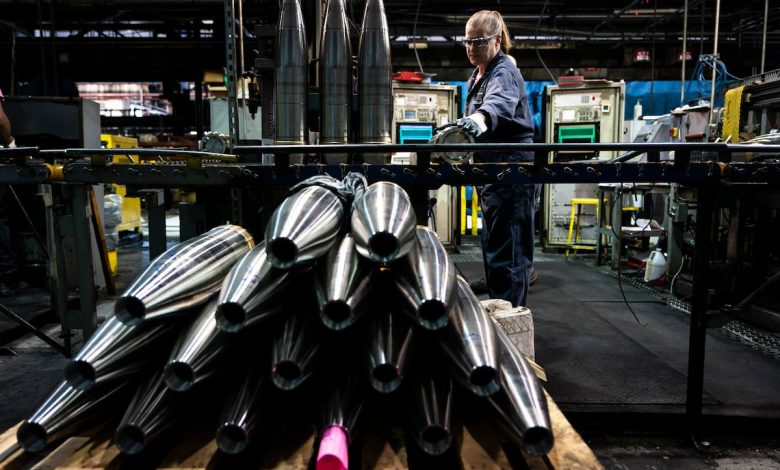House proposes manufacturing network to boost wartime arms production

House lawmakers want the Pentagon to establish a network of high-tech commercial factories that could be tapped during wartime to mass produce weapons.
The House Appropriations Committee’s defense panel proposed $131 million in its draft of fiscal 2026 military spending legislation for the Defense Department to create a Commercial Reserve Manufacturing Network. The network would include companies qualified to quickly shift from producing commercial goods to rapidly scaling weapons production when called upon.
The committee, which released its bill Tuesday, directs the department to craft a plan to qualify the first factory. That plan is due within 30 days of the legislation’s signing.
The Defense Department already has several models for fostering standby wartime capacity within the commercial sector. The Air Force’s Civil Reserve Air Fleet contracts with commercial airlines to provide additional airlift in emergencies, and the Navy’s National Defense Reserve Fleet provides a similar capability at sea. The Space Force is the newest service to adopt this approach, awarding initial contracts in March for its Commercial Augmentation Space Reserve, which will provide space-based services in peacetime that can be scaled up during crisis.
The proposal for at-the-ready manufacturing capacity comes amid deepening concerns about the People’s Republic of China and its ability to quickly scale and deliver military systems to the field. That speed, juxtaposed against what the committee calls “the calcification of the United States defense acquisition system,” has lawmakers and defense officials alike looking for ways to strengthen the military industrial base with additional capacity and new technology.
“Action is needed to immediately accelerate the Department’s adoption of commercially available artificial intelligence (AI)-driven additive manufacturing factories to preserve America’s military advantage,” the committee wrote in a report accompanying its spending proposal. “The Department has an exceptional opportunity to scale advanced manufacturing technologies in a way that bolsters the defense industrial base and the broader American industrial base.”
The committee’s directive echoes a recommendation made in a report released in January by billionaire and former chair of the Defense Innovation Board Michael Bloomberg. Authored by several defense experts and former DOD officials, the report offers a path forward for mobilizing the industrial base. It also specifically advocates for the creation of a Civil Reserve Manufacturing Network that would establish “ready-to-scale defense production” and calls for Congress to fund it as soon as FY26.
In testimony to the Senate Armed Services Committee in February, Nathan Diller, one of the report’s authors, highlighted that recommendation and called the offshoring of defense manufacturing a crisis. Diller, a former House Appropriations Committee staffer and one-time director of AFWERX, the Air Force’s innovation arm, now leads Divergent Technologies, an automotive and aerospace manufacturing firm that is broadening the scope of its digital and AI-enabled factory to also produce cruise missiles and other defense systems.
“Right now, we literally are printing hyper car frames in the morning and cruise missiles in the afternoon,” Diller said in his written testimony. “We are in agreements with most of the defense primes and many startups, delivering capabilities for air, land, sea, and space during all phases of the life cycle.”
Diller emphasized the role that digital tools and AI have played in enabling his firm to broaden its scope.
“This is possible today with AI-driven manufacturing,” he said. “DoD has an opportunity to lead the way – driving adoption of dual-use technology and with it a resurgence in US manufacturing, while reducing taxpayer burden for defense.”
The Pentagon in recent years has emphasized the need for rapid production and scaling as a means to both replenish depleted weapons stocks and field low-cost systems like attritable drones in large numbers. Innovative manufacturing techniques are one way to get after that challenge.
Along those lines, the Defense Innovation Unit in April launched its Blue Manufacturing Marketplace, which is designed to connect technology firms with vetted advanced manufacturing companies whose production approaches could bring speed, scale and security to the defense industrial base.
DIU is currently reviewing proposals for its first round of companies, vetting manufacturing firms to make sure their supply chains are secure. The marketplace will then provide a venue to link those vendors with companies who could benefit from their technology.
Courtney Albon is C4ISRNET’s space and emerging technology reporter. She has covered the U.S. military since 2012, with a focus on the Air Force and Space Force. She has reported on some of the Defense Department’s most significant acquisition, budget and policy challenges.







